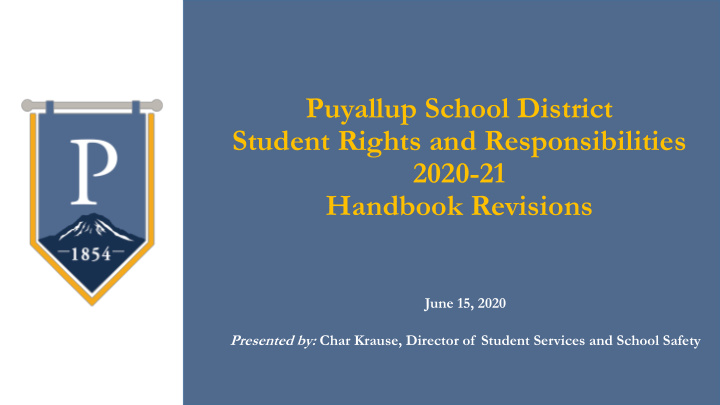



Puyallup School District Student Rights and Responsibilities 2020-21 Handbook Revisions June 15, 2020 Presented by: Char Krause, Director of Student Services and School Safety
Why we revise the Rights & Responsibilities annually • Changes in law and/or policy • OSPI recommendations • Social trends • Evolving best practices in school discipline
The Process • Rights & Responsibility Committee • Legal review • Parent Review Committee • Presentation of updates to board
Highlighted Changes for 2020-21 • Section I : Introduction and Section II: Student Discipline Terms and Procedures ✓ Minimal edits and formatting • Section III : Student Conduct Expectations and Rules ✓ Streamlined redundant language regarding consequences for violating conduct rules ✓ Streamlined explanation of offenses and expectations for clarity ✓ Added back “Other Types of Weapons” section under Firearms and Dangerous Weapons section that was inadvertently left out in 2019- 20 handbook
Highlighted Changes for 2020-21 Continued • Section III : Student Conduct Expectations and Rules ✓ Harassment, Intimidation and Bullying (HIB) Section modified to mirror terms and rules established in Policy and Regulation 3207- Prohibition of HIB which was updated in February 2020 ✓ More specificity under technology prohibiting the use of technology that disrupts the educational process, violates the privacy of others or violates school rules ✓ Threats moved to having own section, and references section on HIB ✓ Compliance Officer contact information updated
Example of Streamlining STUDENT CONDUCT RULES III B ... Any student who violates the conduct rules listed below is, depending upon the individual circumstances involved, subject to discipline, including suspension or expulsion. Students are also subject to emergency expulsion for violations of these rules or in any other situation when the student’s presence poses an immediate and continuing danger to, other students or school personnel, or an immediate and continuing threat of material and substantial disruption of the educational process.
Addressing Disproportionality in Student Discipline is Ongoing Disproportionality is defined as the presence of students from a specific group in an educational program being higher or lower than one would expect based on their representation in the general population of students.
Addressing Disproportionality in Student Discipline is Ongoing
Addressing Disproportionality in Student Discipline is Ongoing
Understanding Data Context is Critical • Special Program within a building • Individual students with behavior challenges and multiple offenses • Errors in data entry • Inconsistent data entry • Building systems and staff capacity
Methods for Addressing Disproportionality in Discipline • Collaboration and communication is key- it’s a team effort! • Review of disaggregated building and district level discipline data K-12 • Set measurable goals based on specific data • Targeted interventions within tiers of behavior support • Social emotional learning instruction and support • Identification of resources • Professional development • Decreased exclusion time when possible and safe to do so • Alternatives to exclusion when possible and safe to do so
Recommend
More recommend